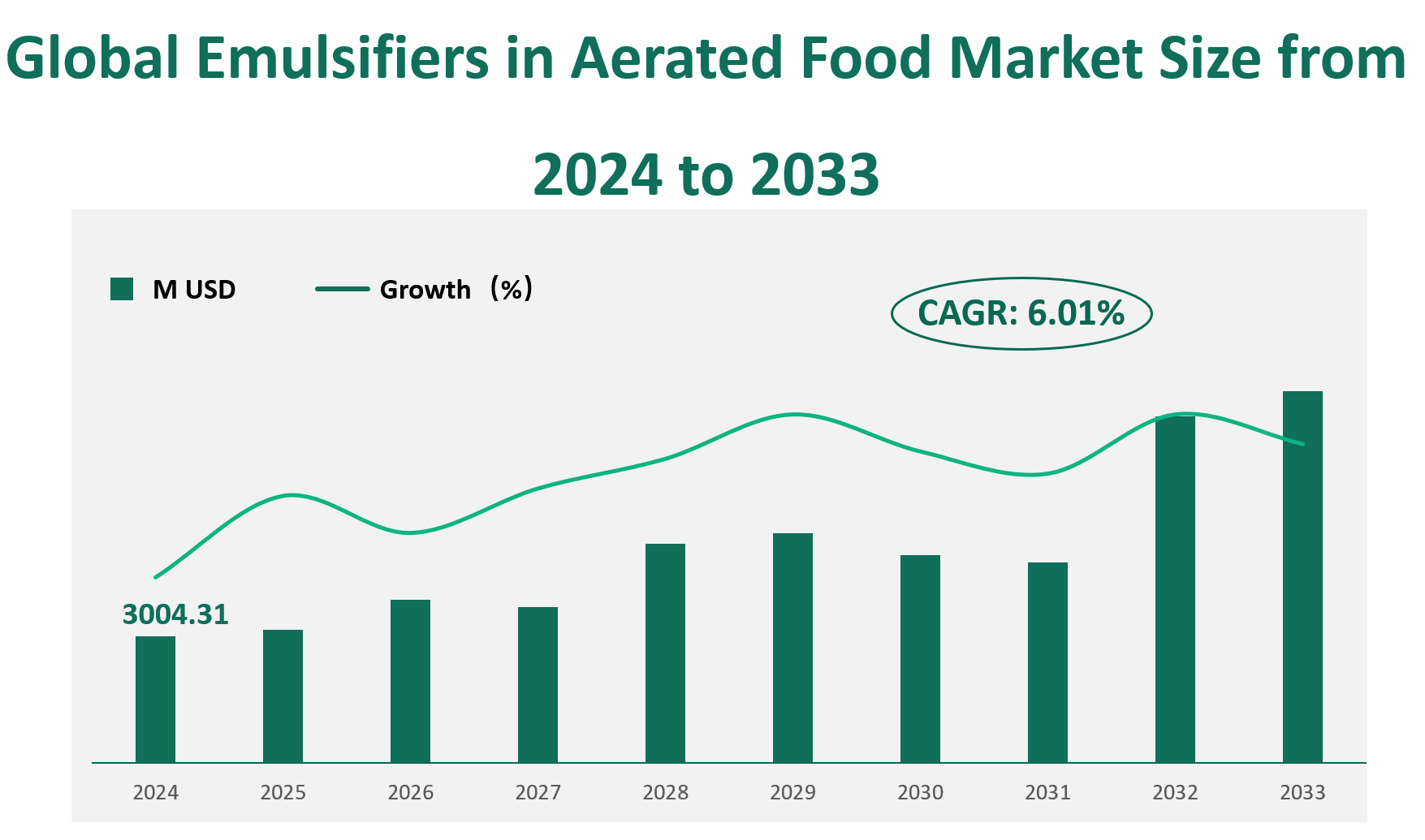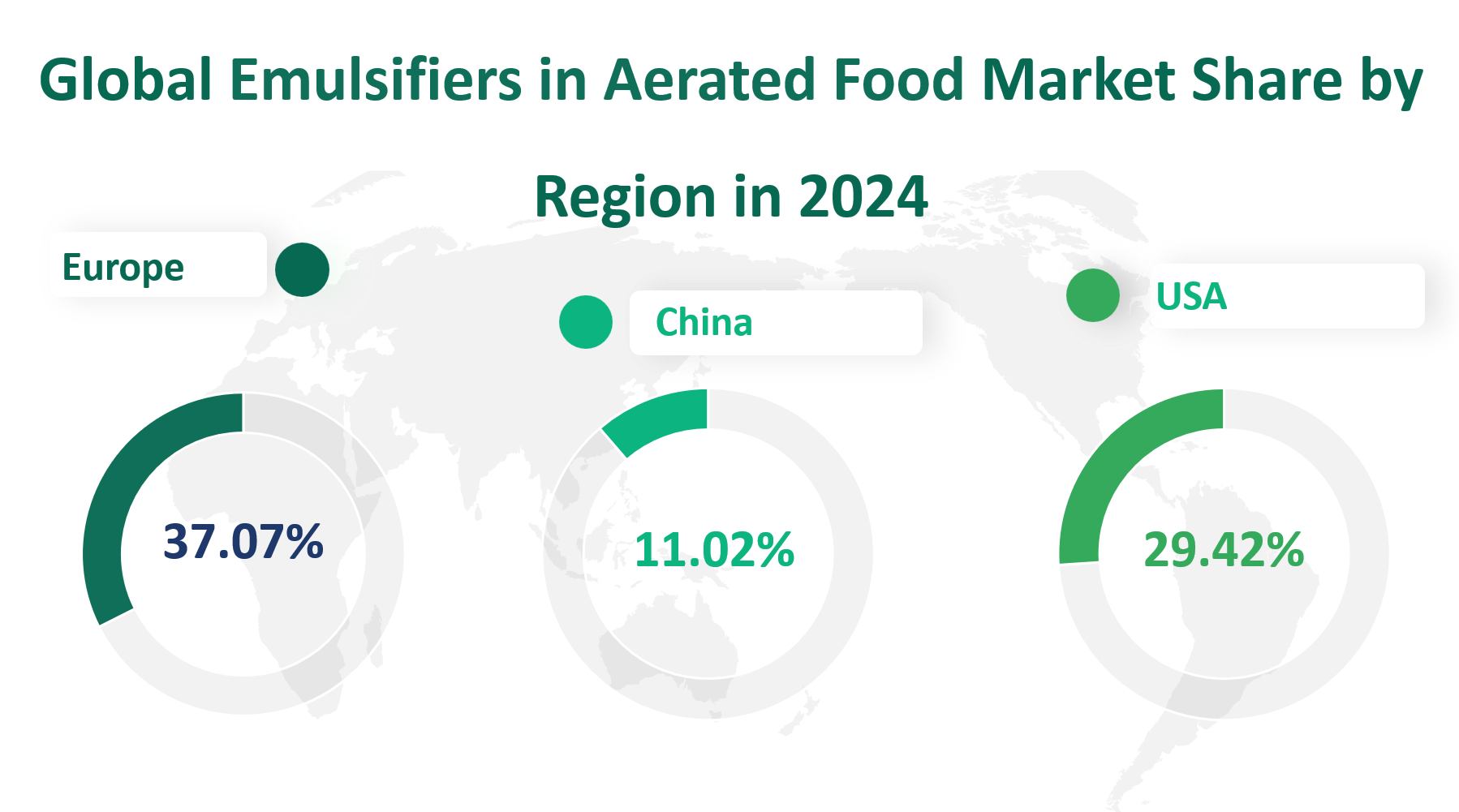1. Emulsifiers in Aerated Food Market Value and Growth Forecast
The global Emulsifiers in Aerated Food market is projected to reach a market size of $3004.31 million in 2024, with a CAGR of 6.01% from 2024-2033.
Emulsifiers in aerated food, also known as emulgents or surfactants, are surface-active agents that facilitate the blending of immiscible liquids such as oil and water, creating stable emulsions. These agents are crucial in the production of aerated foods like mayonnaise, ice cream, and baked goods, where they contribute to a smooth texture, prevent separation, and extend shelf life.
Figure Global Emulsifiers in Aerated Food Market Size from 2024 to 2033

2. Driving and Limiting Factors of Emulsifiers in Aerated Food Market Growth
The Emulsifiers in Aerated Food market is influenced by a multitude of driving and limiting factors. On the positive side, the increasing demand for aerated food products due to their appealing texture and taste, along with the growing health consciousness among consumers, is a significant driver. The preference for low-fat and reduced-calorie food products has led to an increased use of emulsifiers, which play a crucial role in developing healthier options while maintaining taste and texture.
Another factor contributing to market growth is the escalating demand for processed foods. The convenience offered by processed foods aligns with today’s fast-paced lifestyle, and emulsifiers are essential in enhancing their quality, stability, and shelf life. However, the market faces challenges such as the high costs associated with the extraction of food emulsifiers from natural resources and fluctuations in raw material prices. These factors can lead to higher production expenses and affect the affordability of emulsifiers for food producers, potentially impacting the overall market growth.
3. Emulsifiers in Aerated Food Market Technological Innovations and Corporate Developments
In the realm of technology innovation, the Emulsifiers in Aerated Food market has seen significant advancements. Companies are focusing on developing clean label emulsifiers derived from natural sources to cater to the growing consumer preference for natural and transparent ingredients. Additionally, the increasing demand for plant-based aerated foods has spurred innovation in the development of plant-based emulsifiers, aligning with the trend towards sustainability and eco-consciousness.
The market has also witnessed notable corporate mergers and acquisitions, which have reshaped the competitive landscape. For instance, the acquisition of Corbion’s emulsifiers business by Kingswood Capital Management signifies the private equity firm’s strategic investment in the industry, highlighting the market’s potential for growth. Similarly, Kerry Group’s acquisition of the Lactase Enzymes Business strengthens its position in biotechnology solutions, underlining the importance of enzyme technology in creating lactose-free and sugar-reduced dairy products.
4. Product Types of Emulsifiers in Aerated Food Market
The global emulsifiers in aerated food market is segmented by type into lecithin, mono- and diglycerides, sodium stearoyl lactylate, and others.
Lecithin is a natural emulsifier derived from sources such as soybeans or egg yolks. It is widely used in aerated foods like cakes, mousses, and whipped toppings to create stable emulsions by promoting the interaction between water and fat, enhancing texture, and mouthfeel. In terms of market size, lecithin is expected to generate revenue of approximately $1,259.44 million in 2024, holding a significant share of the market. This can be attributed to its versatility and the growing preference for natural ingredients in food products.
Mono- and diglycerides are produced through the glycerolysis of triglycerides and are typically sourced from vegetable oils. They are used to improve the stability and volume of aerated products by reducing surface tension at the oil-water interface. The market size for mono- and diglycerides in 2024 is forecasted to be around $709.22 million. This type of emulsifier is popular due to its effectiveness in a variety of food applications, contributing to its substantial market share.
Sodium stearoyl lactylate (SSL) is derived from the esterification of stearic acid with lactic acid and is used as an emulsifier and dough strengthener, particularly in baked goods. SSL enhances the crumb structure and texture of aerated products. The market size for SSL in 2024 is projected to be around $557.11 million. While SSL has a smaller market share compared to lecithin and mono- and diglycerides, it is valued for its specific applications in baked goods.
In conclusion, the emulsifiers in aerated food market are diverse, with lecithin leading in market share due to its natural origin and broad applicability.
Table Emulsifiers in Aerated Food Market Sizes and Shares by Product Type in 2024
Product Type | Market Size (M USD) | Market Share (%) |
|---|---|---|
Lecithin | 1259.44 | 41.92% |
Mono- and diglycerides | 709.22 | 23.61% |
Sodium Stearoyl Lactylate | 557.11 | 18.54% |
Others | 478.53 | 15.93% |
5. Applications of Emulsifiers in Aerated Food
The global emulsifiers in aerated food market is segmented by application into bakery products, dairy & frozen desserts, and others.
Bakery Products includes a wide range of products such as bread, cakes, and other baked goods where emulsifiers are used to improve crumb softness, volume, and texture. They help in the distribution and stabilization of air within the dough, which is essential for achieving the desired lightness and texture. In 2024, the bakery products segment is expected to generate revenue of approximately $1,605.31 million, accounting for the largest market share. This can be attributed to the large-scale consumption of bakery products globally and the increasing demand for premium and specialty bakery items that require emulsifiers for texture optimization.
Dairy & Frozen Desserts application involves the use of emulsifiers in dairy products like ice cream, cheese, and frozen desserts. Emulsifiers in these products help in modifying properties such as texture and increasing shelf life. They also stabilize air cells, which are vital for the creamy texture and mouthfeel of these products. The market size for dairy & frozen desserts in 2024 is forecasted to be around $1,006.97 million. This segment is significant due to the global popularity of dairy products and the growing trend of indulgence in frozen treats.
When analyzing the market share, it is clear that the bakery products application has the biggest market share in 2024, primarily due to the widespread consumption of bakery items and the critical role emulsifiers play in achieving the desired texture and quality of these products.
Table Emulsifiers in Aerated Food Market Sizes and Shares by Application in 2024
Application | Market Size (M USD) | Market Share (%) |
|---|---|---|
Bakery Products | 1605.31 | 53.43% |
Dairy & Frozen Desserts | 1006.97 | 33.52% |
Others | 392.03 | 13.05% |
6. Regional Market Sizes of Emulsifiers in Aerated Food
Europe stands out as the largest regional market by revenue in 2024, account. This region’s market size in 2024 is estimated to be USD 1113.78 million.
The United States follows closely with a substantial market size. This region’s market size in 2024 is estimated to be USD 883.80 million, reflecting the country’s large consumer base and the presence of numerous food manufacturing companies.
China is expected to have a market size of USD 331.22 million in 2024, driven by rapid urbanization, increasing disposable income, and the rising demand for convenience foods.
Japan’s market size is also projected to be USD 183.60 million in 2024, influenced by the country’s demand for high-quality aerated food products and the use of emulsifiers in various food applications.
Latin America is projected to have a market size of USD 155.44 million in 2024, with growing demand for aerated food products and the potential for market expansion.
Figure Global Emulsifiers in Aerated Food Market Share by Region in 2024

7. Analysis of the Top 3 Companies in the Emulsifiers in Aerated Food Market
7.1 IFF (Danisco)
Company Introduction and Business Overview: IFF, known for its brand Danisco, is a global leader in the flavors and fragrances industry, creating what matters for a better world through its products. The company operates in the taste, texture, scent, nutrition, enzymes, cultures, soy proteins, and probiotics categories, with a presence in over 40 countries. IFF is part of the S&P 500 Index and is headquartered in New York City.
Products Offered: IFF offers a range of emulsifiers and lecithins sourced from vegetable oils, which are used in various applications from bakery, confectionery, margarines, and spreads to dairy and culinary products. Their emulsifiers help in improving quality, enhancing nutrition, reducing costs, and maximizing product lines.
Sales Revenue in 2024: IFF (Danisco) is projected to have a sales revenue of $612.56 million in 2024, reflecting its strong market position and the demand for its high-quality emulsifiers in the aerated food industry.
7.2 Palsgaard
Company Introduction and Business Overview: Palsgaard A/S, established in 1919, is a Dutch organization that specializes in the manufacture and supply of emulsifiers and stabilizers for the global market. The company is renowned for its expertise in stabilizers and emulsifiers for bakery, confectionery, and dairy products.
Products Offered: Palsgaard’s Emulpals® range is a market-leader in powdered, whipping-active cake emulsifiers. These emulsifiers are allergen-free, plant-based, and designed for ease of use in various cake recipes, offering high aeration and softness.
Sales Revenue in 2024: Palsgaard’s sales revenue will reach $335.34 million in 2024.
7.3 Corbion
Company Introduction and Business Overview: Corbion is a global market leader in lactic acid and its derivatives, and a leading supplier of food preservation solutions, functional blends, and algae ingredients. The company has a strong presence in the food emulsifiers market, offering solutions that extend beyond baking to processed foods, dairy products, and more.
Products Offered: Corbion’s emulsifiers are known for their multifunctionality, including starch complexing, protein interaction, aeration and stabilization, crystal modification, and lubrication. They offer a range of emulsifiers that help preserve textures, taste, and extend the shelf life of aerated food products.
Sales Revenue in 2024: Corbion will generate $177.64million in sales revenue in 2024.





